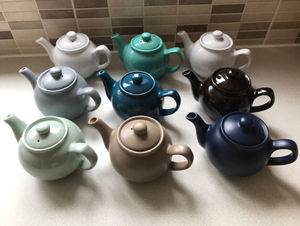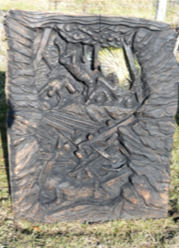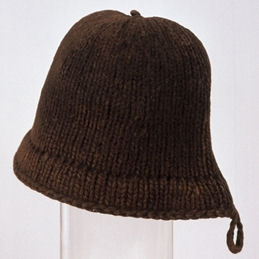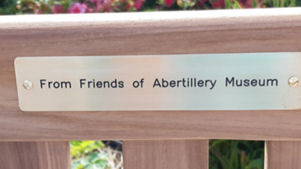Dates for your Diary
From Thursday 22nd July* we will be returning to three day opening. Plus ‘Hunt the Teddy’ and photo quiz will be running throughout school holidays starting on Thursday 22nd July ( 10am-1pm)
Museum opening times
The Museum is open to the public, free of charge:
Thursday* to Saturday 10am – 1pm
June 100 Club
This month’s prize numbers were drawn by members Audrey and Dennis Osland and the lucky winners are:-
No. 20 Gaynor Tucker £20
No. 96 Margaret Dyer £10
Last month’s numbers were drawn by Val Rosser, not Yvonne Rosser as it said in last month’s newsletter. Apologies Val! If you would like to join our 100 club and be in with a chance of winning, it costs just £1 a month.
Ask at the museum for further details.
I’m a Little Teapot….
These delightful little individual teapots were found for us through Facebook by one of our new volunteers, Katie Morgan, and they are now at our café ready and waiting for our visitors to enjoy a nice pot of tea with their slice of cake. And if a brew isn’t your cup of tea, then how about trying one of the coffees that we are trialling? Choose from cappuccino, mocha or skinny latte. Do pop in soon!

New Exhibit

If you have visited the museum recently, you may have noticed this new exhibit. The TV, which is in its own cabinet, is a piece of furniture in its own right and is circa early 1960s.
It was kindly donated to us by Gina Clare from Six Bells.
Get Well Soon Don
Don Bearcroft, is hoping to be home soon after a lengthy hospital stay. We wish him well.
Llanerch Colliery Disaster
 It is a sad fact that our part of South East Wales experienced many deaths of men and boys in pit explosions. Llanerch Colliery is located at Abersychan, more or less over the other side of the mountain from Llanhilleth and, like many former colliery sites, little remains today. How different from its heyday when the surface was crammed with pithead gear, buildings and rail lines and hundreds of people worked there. Llanerch Colliery, established in about 1830, was not unusual for the deaths which occurred quite regularly as a result of accidents but the terrible explosion of February 1890, when 176 men and boys died, surpassed anything that had occurred previously at the colliery. The use of naked lights underground was commonplace although safety lamps were coming into use, and it is believed that one of these naked flames ignited an accumulation of gas which then caused an explosion which ripped through the underground passages – an explosion which was heard for miles around.
It is a sad fact that our part of South East Wales experienced many deaths of men and boys in pit explosions. Llanerch Colliery is located at Abersychan, more or less over the other side of the mountain from Llanhilleth and, like many former colliery sites, little remains today. How different from its heyday when the surface was crammed with pithead gear, buildings and rail lines and hundreds of people worked there. Llanerch Colliery, established in about 1830, was not unusual for the deaths which occurred quite regularly as a result of accidents but the terrible explosion of February 1890, when 176 men and boys died, surpassed anything that had occurred previously at the colliery. The use of naked lights underground was commonplace although safety lamps were coming into use, and it is believed that one of these naked flames ignited an accumulation of gas which then caused an explosion which ripped through the underground passages – an explosion which was heard for miles around.
 The grief felt by the families, friends and local community must have been unimaginable and yet life was such that at Llanerch, the necessary repairs overground and underground were made and men resumed working at the pit just a few days later. People far and wide rallied around at the time of the catastrophe and in the days and weeks that followed. The involvement of people living in Abertillery, in support of the relief fund, is probably not untypical – the Abertillery Histrionic Society and Temperance Brass Band proposed to hold fund raising entertainments while miners at Cwmtillery Colliery resolved to donate one shilling from each adult and sixpence from each boy.
The grief felt by the families, friends and local community must have been unimaginable and yet life was such that at Llanerch, the necessary repairs overground and underground were made and men resumed working at the pit just a few days later. People far and wide rallied around at the time of the catastrophe and in the days and weeks that followed. The involvement of people living in Abertillery, in support of the relief fund, is probably not untypical – the Abertillery Histrionic Society and Temperance Brass Band proposed to hold fund raising entertainments while miners at Cwmtillery Colliery resolved to donate one shilling from each adult and sixpence from each boy.
 In November 1890 a memorial window was installed at Trevethin Church in the memory of the 176 who died at Llanerch Colliery and five workers who had died in January 1890 at Glyn Pits. In more recent times, a small memorial was put in place above Llanerch Colliery site but many felt the scale of the 1890 disaster was such that it warranted a more substantial and sensitive memorial to the dead. Eventually, in 2019, this was achieved with the installation of a memorial listing the names and ages of the dead and the following year saw the installation of a series of wooden carvings that graphically depict the disaster. The site isn't the easiest to find but it is well worth a visit.
In November 1890 a memorial window was installed at Trevethin Church in the memory of the 176 who died at Llanerch Colliery and five workers who had died in January 1890 at Glyn Pits. In more recent times, a small memorial was put in place above Llanerch Colliery site but many felt the scale of the 1890 disaster was such that it warranted a more substantial and sensitive memorial to the dead. Eventually, in 2019, this was achieved with the installation of a memorial listing the names and ages of the dead and the following year saw the installation of a series of wooden carvings that graphically depict the disaster. The site isn't the easiest to find but it is well worth a visit.

The wooden carvings, depicting the disaster
Jen Price
The Monmouth Cap
Did you know that it was once a legal requirement for all working class men and boys of age 6 and over to wear a cap on certain days? I certainly didn’t until, that is, it was featured in a recent episode of the TV show, The Great British Sewing Bee and it all stemmed from Monmouth wool…
In the 14th century, an area in the northern part of Monmouth known as Archenfield, was well known for its high quality wool made from Ryeland sheep. It was found to be ideal for a high quality felt and so by the 15th century a cap making industry had established itself in and around the Monmouth area. The caps were made by hand, mainly by men and the town of Overmonnow in Monmouthshire became known locally as ‘Cappers Town’.
Cap wearing became hugely popular in the 15th and 16th century especially among labourers and sailors. To protect the cap making industry, in 1488 ‘The Cappers Act’ was passed by parliament, forbidding the wearing, under threat of a fine, any cap made abroad.
This went even further in 1571 when, in England and Wales, (Scotland would not join the union until 1707) under the reign of Queen Elizabeth I, it was made compulsory for the working classes, over the age of 6, to wear a British made wool cap every Sunday and holidays. Only ‘Maids, ladies, gentlewomen, noble personages and every Lord, knight and gentleman of twenty marks land’ were exempt.
And so the wearing of a cap became synonymous with the working classes. The fine was steep at 3s and 4d for every day it was not worn which was equivalent to several days pay so no-one wanted to be caught without their cap! The law was repealed in 1597 as it was found to be unworkable and difficult to enforce; a bit like some of our Covid laws!

The photo shown here is the only known surviving example of a Monmouth cap and the cap belongs to Monmouth Museum which is now open again though on reduced hours and booking is required. For more information use the link below or telephone them on 01600 710630. https://www.monlife.co.uk/heritage/monmouth-museum/
And for more information on the Monmouth Cap, use this link:
https://en.wikipedia.org/wiki/Monmouth_cap
Sally Murphy
Bob a Job Week
Do you remember Bob a Job Week? It will give away your age if you do because it ended in 1992 as we moved into an age where the world was a much less safe place for youngsters. The concept was introduced by the Scout Movement Founder, Lord Baden Powell, in 1914, the intention being that it would be a good turn day but it evolved into a week-long event. The first Bob a Job Week took place in April 1949; the name came about because the young boys would expect to be paid a shilling – a ‘bob’ or 5p in today's money – for their 'job'. It was renamed 'Scout Job Week' in 1970. As a girl I wasn't involved but I can remember that Scouts would do all sorts of odd jobs – polishing shoes, a bit of gardening, cleaning cars – anything really. I assume the money was used by the Scout Movement for equipment or scout camps but I don't really know. Are there any readers who can send us their memories of Bob a Job Week?
Jen Price
Have you been ‘pwned’?
With us all forced on-line much more since March 2020, scammers have been very active in trying to steal from us. One way to see if you’ve been compromised is to enter your email address (and you can also check your telephone number here too) into the following website.
If it tells you that you have been ‘pwned’ the details will be further down the page, just scroll down to view. But what does it mean if you have been pwned? Well, suppose it told you that you were pwned on say, let’s make a name up, Betterbuys* supermarket website, what it means is that at some point ‘Betterbuys’ had been subject to a data breach where some of its customer’s details were stolen and those details might have included the email address and the password you used whenever you shopped at ‘Betterbuys’. Scammers then tend to sell this data on the ‘dark web’ for others scammers and thieves to use. To beat them at their own game, log into your account with ‘Betterbuys’ and change your password (your email address can stay the same) and do the same for any other company that you have used the same password and email address for.
This is why it is so important to use a different password for every site as once your password is ‘out there’, the scammers tend to go to other sites and try their luck. They know that many people tend to use the same password on multiple sites and so they will enter in your email address and the password you used at the supermarket and see if you have used the same password for say, Amazon. If you have, bingo, they are in to your Amazon account and can go on a shopping spree leaving you to pick up their bill.
There are apps out there that can manage your passwords but if that is too complicated then you could do worse than keep a book and write them all down as long as you keep the book somewhere safe of course. And if ‘computer’ asks you if you want it to ‘save’ a password for you, always best to click ‘never’.
Sally Murphy
*’Betterbuys’ used here is a made up name and should not be confused with any company with a similar name.
Thanks from Judith
Judith Williams had been a volunteer at the museum for 14 years until she and her husband Alan moved to Swansea in August 2019. I’m pleased to report they have now settled into their new home and she has sent this message:-
At last l have purchased the bench that Friends at the museum contributed to when we moved to Swansea. Isolating because of Covid and then the disruption in the Suez Canal, both made this purchase harder than we expected but at last we have it in the garden, complete with inscription and are ready for the summer. Thank you all.
Judith Williams.

Judith and Alan enjoying their new bench and below, the bench’s inscription.

QR Codes are coming to the museum!
 In fact a few have already arrived! And for those not sure what a QR code is, it is short for Quick Response Code. It comprises a pattern of dots which, when scanned by the camera on a ‘Smart Phone’ takes you to a website. The one pictured here, when scanned, will take you directly to the museum’s Facebook page. So next time you visit the museum, keep a look out for these codes and scan it to read more about the artefact you are looking at!
In fact a few have already arrived! And for those not sure what a QR code is, it is short for Quick Response Code. It comprises a pattern of dots which, when scanned by the camera on a ‘Smart Phone’ takes you to a website. The one pictured here, when scanned, will take you directly to the museum’s Facebook page. So next time you visit the museum, keep a look out for these codes and scan it to read more about the artefact you are looking at!
Top Of Page
